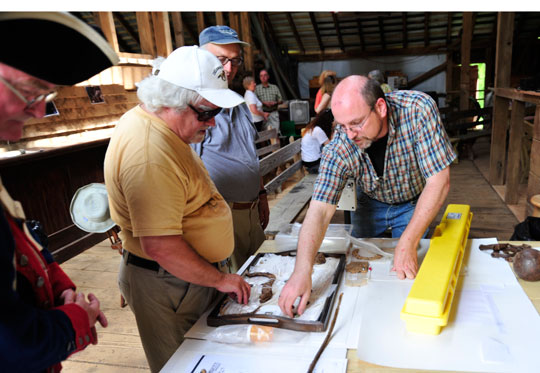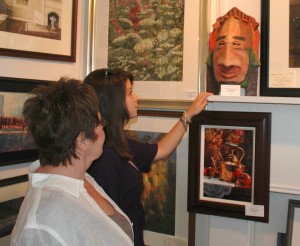A graduate student at Temple University has been digging for evidence that could show the Battle of Brandywine was fought over a larger area than previously believed. Some of the research could also show where John Chads had his Chadds Ford ferry.
Kevin Michael Donaghy, a doctoral student in archeology, has been sifting through the soil at the Spackman Farm in Thornbury Township, Chester County, for the past three years looking for evidence that some of the Sept. 11, 1777 battle was fought on that property.
Prior to the fieldwork, Donaghy researched archives for historical documentation. He also went to Harrisburg and reviewed the documents of the Brandywine Battlefield task Force.
“What I’m looking for is not only where did people fight, but where they didn’t fight,” he said in a brief interview before addressing visitors to the farm on June 23. “When you’re looking at preservation, you need to know where people fought to protect the right land. We have land where people bled to death, but yet we have developments built over them with streets named after generals. My question on the Spackman Farm is really ‘How much activity really did take place here.’”
None of his findings have been conclusive, at least so far, he said, but he’s continuing to look. What he has found are horseshoes and pieces of nails, but they can’t be distinguished from what was used in civilian life.
“We haven’t hit a smoking gun. We haven’t hit that great big cluster of artifacts that you hope to find…There’s nothing stamped, ‘Property of his Royal Majesty King George,’” he said.
What he’d like is to be able to use some ground penetrating radar to survey the horse pasture and the intersection of Route 926 and Thornbury Road and behind the store at the farm, adjacent to the Birmingham Meetinghouse where there was military action.
“If the troops did move this way, that’s where we’d find the highest concentration [of artifacts],” Donaghy said.
During his address to members of the Thornbury Township Historical Preservation Committee and other visitors to the farm last Sunday, Donaghy showed period maps that indicate troop movement into Thornbury from Osborne Hill and the Birmingham Meeting and battle action on the farm.

“Historical accounts indicate fighting at Sandy Hollow spilled over to a ravine. That could be at the O’Dell property [in Birmingham Township] or the Spackman Farm.
There was one finding that he said is significant. Donaghy found pieces of flaked white stone that indicate the presence of Indian stonework on the property.
“We don’t want the battlefield investigation to make all the previous history here disappear.”
This summer he will be working in the area of the John Chad House in Chadds Ford Township, looking for clues as to how close fighting was to the house. During the battle, Wilhelm von Knyphausen led a Hessian division in a feigned direct attack across the Brandywine near the ferry. Fire was exchanged with Gen. George Washington’s troops while the main body of British soldiers flanked Washington’s position from the north. It’s believed that Elizabeth Chads stayed in the house, watching troop movements from her attic windows.
Some preliminary soil testing has already been done. This summer they will be working out the math to determine artillery positions.
Exactly where that piece of the battle took place is still undetermined.
“It’s a real tough question. There are written accounts that say guns were behind [the house] but, as an anthropologist, my question is what, linguistically, is ‘near’ the John Chad House. If there’s nothing else for a couple miles, you could be 150 yards away and be near the John Chad House. It may be the workers’ houses were built on top of the gun locations.”
Donaghy added during the interview that his research in Chadds Ford could lead to a better understanding of where Chads had his ferry by examining the soil and sediment.
“We might find the approach to it,” he said.
Top photo: Doctoral student Kevin Donaghy explains some artifacts to his mentor, David Orr, at the Spackman Farm.
About Rich Schwartzman
Rich Schwartzman has been reporting on events in the greater Chadds Ford area since September 2001 when he became the founding editor of The Chadds Ford Post. In April 2009 he became managing editor of ChaddsFordLive. He is also an award-winning photographer.



Comments